Notes from the Small, Yet Grand, All-Ireland 650B Tyre-Test Party
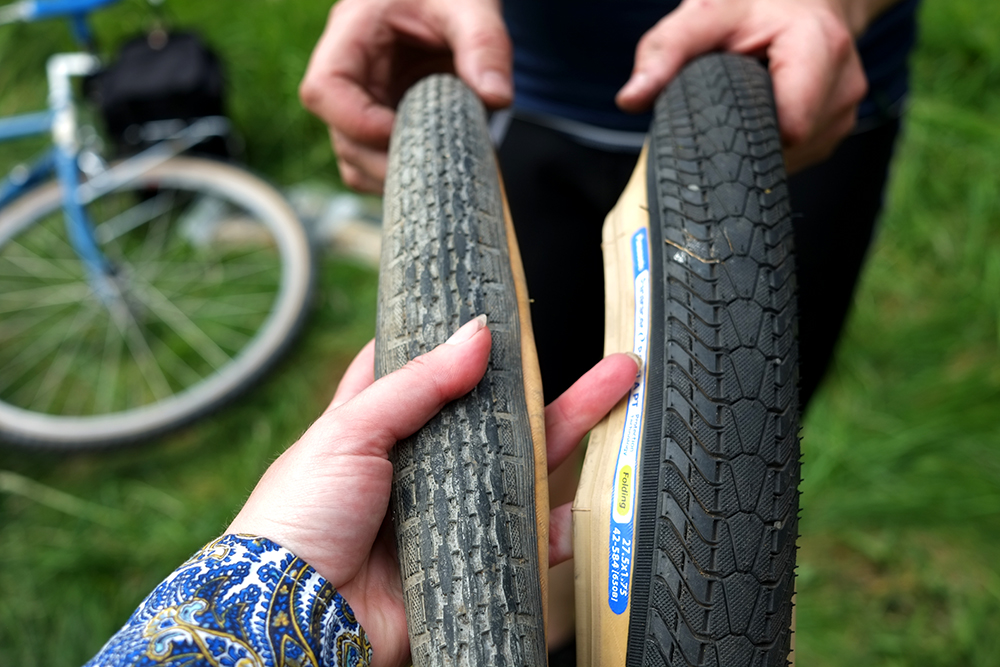
"Hey, how do you like those tyres?"
It is a question we inevitably ask our fellow riders, when we spot them sporting some that are rumored to be good.
And how might they reply? Well, some might reply with unqualified enthusiasm (“Oh, they’re great! They’re the best!”). Others by launching into detailed descriptions of improbably nuanced sensations. Others still will quote the sciencey rhetoric from the latest articles on the subject - as if the technical data trumps personal experience.
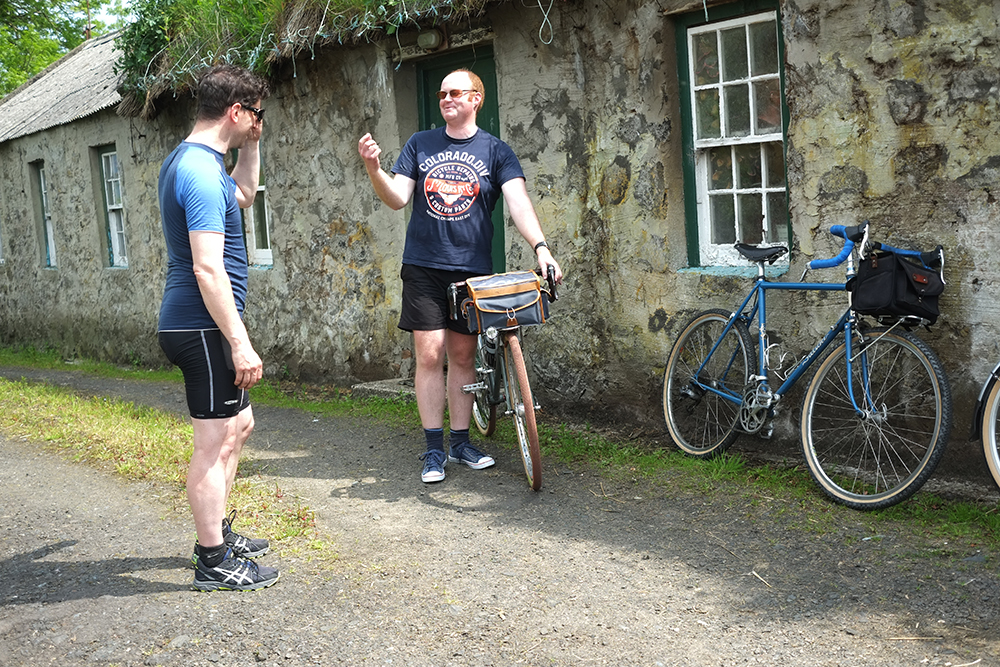
In the realm of actual tyre reviews, whether professional or amateur, things are not all that different. When it comes to 650B tyres in particular - a size that only grew popular over the past 5 years (if “popular” is even the right word), few riders have the breadth of experience necessary to provide context for a proper review as such. So we see a lot of weird subjective stuff. And a lot of rhetoric. And yes, a lot of unqualified enthusiasm (cue my “review” of the Grand Bois Hetres, circa 2010!)
Although, on closer inspection, I am pleasantly surprised to find that my ramblings were not altogether unqualified!
The ride quality of the Grand Bois Hetre tires is truly superb. Better than Schwalbe Delta Cruisers. Better than the Fat Frank and Big Apple tires. Faster too. It is worth [switching to 650B] just to get these tires.Six years later, I still love my Hetres, and I still agree with the above. Except to add that there are now even more options worth switching to 650B for, if you are looking for a tyre that is wide, fast and comfortable.

But just how many options, I had not really thought about, until seven(!) pairs of them landed on my doorstep - courtesy of Merry Sales, the international distributor of Panaracer (and Soma) products. "Try these and see what you think?" said they.
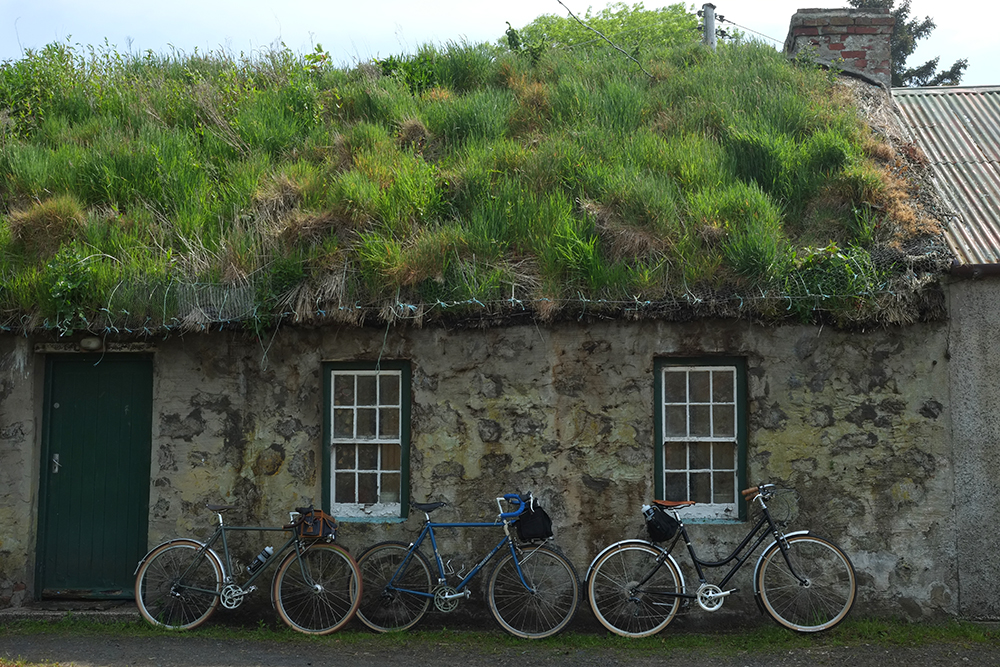
Naturally, I called for reinforcements. And while I feared that finding 650B riders in Ireland would be no easy task, I was immediately contacted by several such persons from around the island. My idea then was to organise a 650B Meet-up, so that we could get a look at each other's bikes, invite others interested to join, and have a tyre-testing party in the process. Unfortunately, as the tentatively-set date approached, most of the fellows had to cancel due to family commitments and such. So in the end we had a cozy, and no less grand Party of Three.
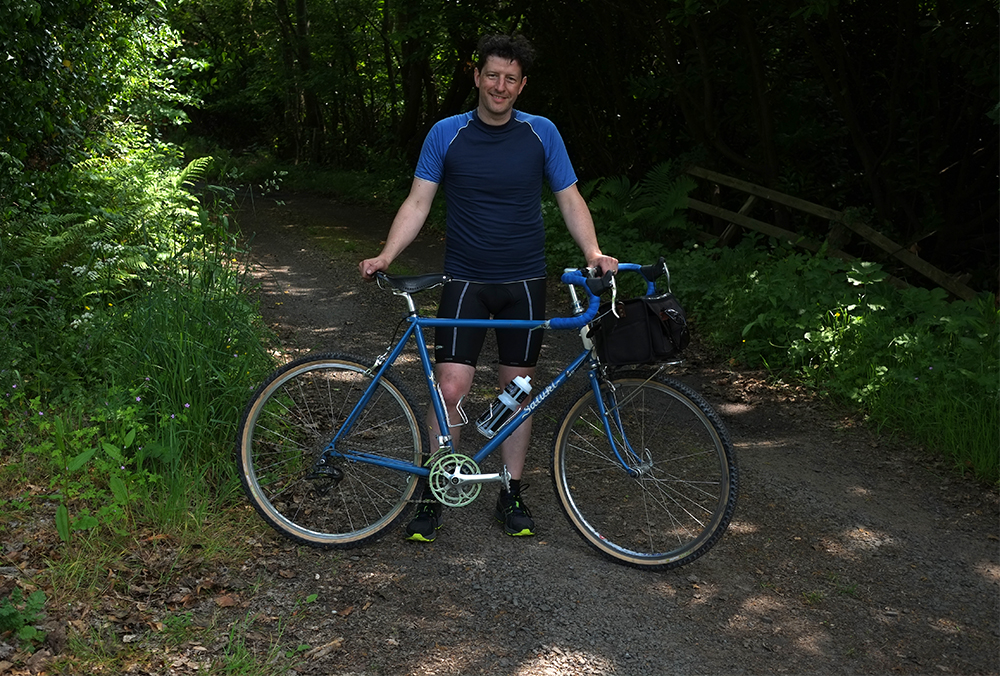
The Guest of Honour, as it were, was a fine Dublin-based fellow named Damian, who'd arrived with his Rivendell Saluki (which he uses for casual road rides, touring, and brevets). I am always curious how riders who live in, say, Ireland, end up with a bicycle like this, so I'm afraid I quizzed and prodded him on this subject considerably - which might result in a separate rider/bike feature at a later date.
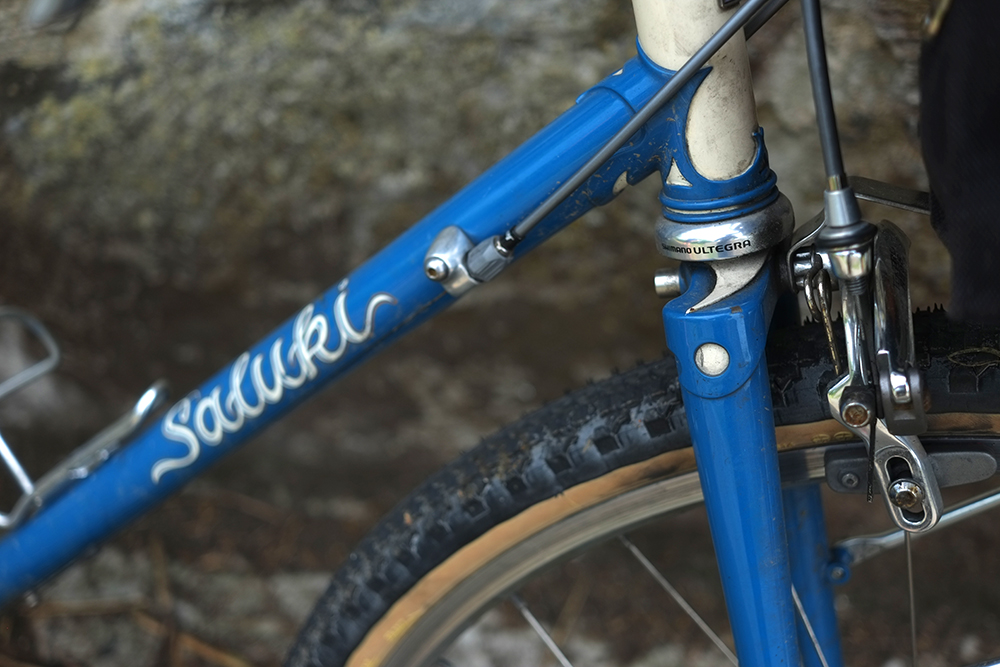
But in any case, the Saluki was Rivendell's predecessor to what is now the Homer Hillsen model. And Damian ordered his in 2007, which - it is rather shocking to realise - is nearly a decade ago! A vintage Rivendell? Well, maybe not quite yet. But give it another 5 years.
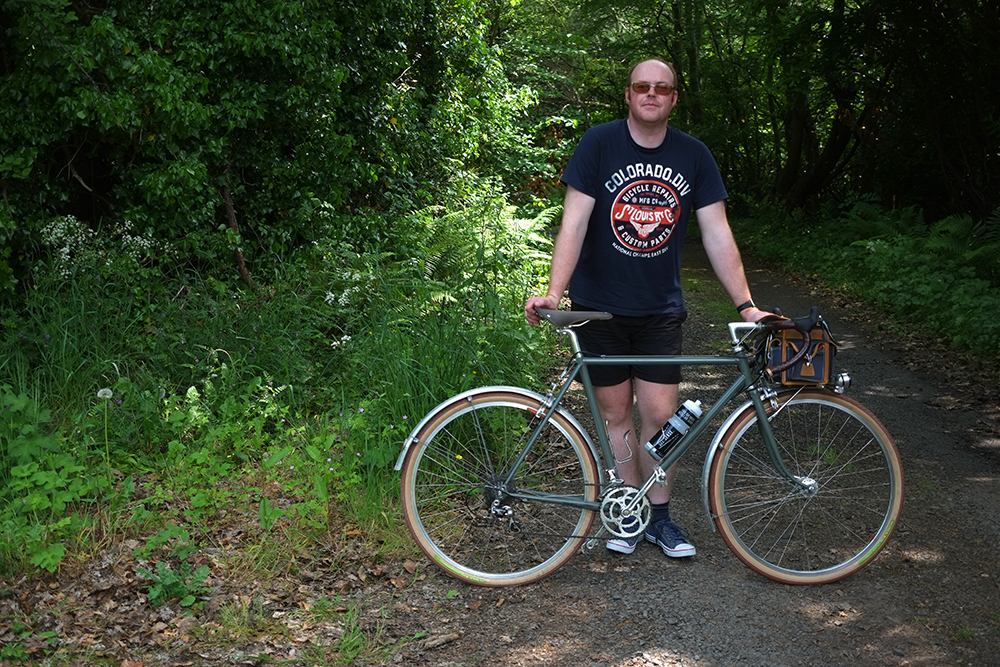
I had also invited Bryan - a.k.a. Elton John, a.k.a. owner of many seemingly plain yet magically-riding old bicycles - whom you've met here before. While Bryan lacks a 650B bike of his own (for now!), he was interested in riding some. And so I handed him my DIY Alice.
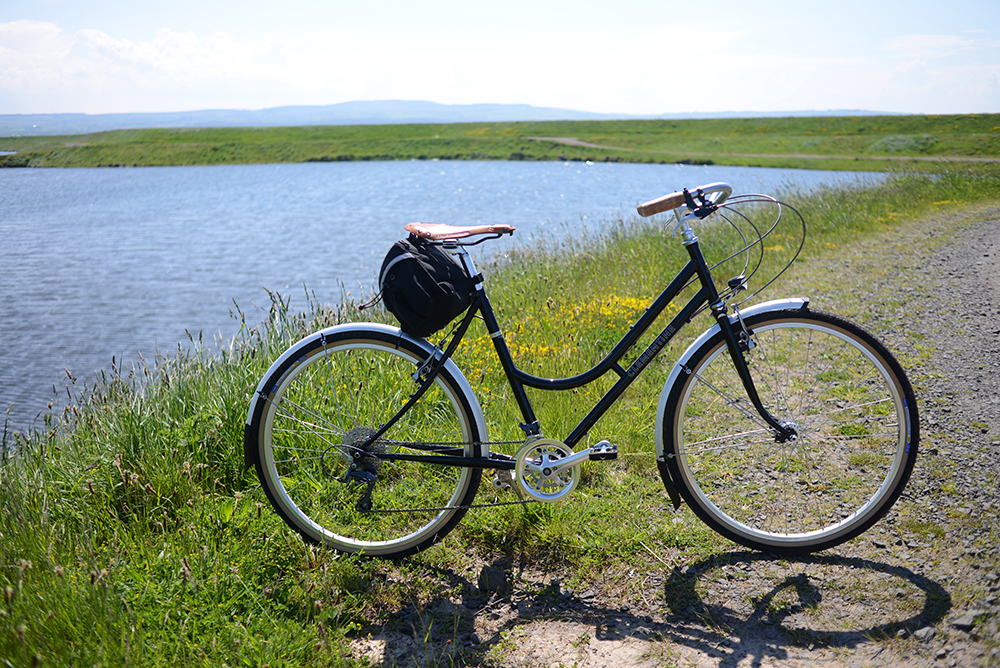
In the meanwhile, I myself hopped on the Rivendell Clementine that I have on loan for review. A convenient option, in its easy on-off for constant photo taking.
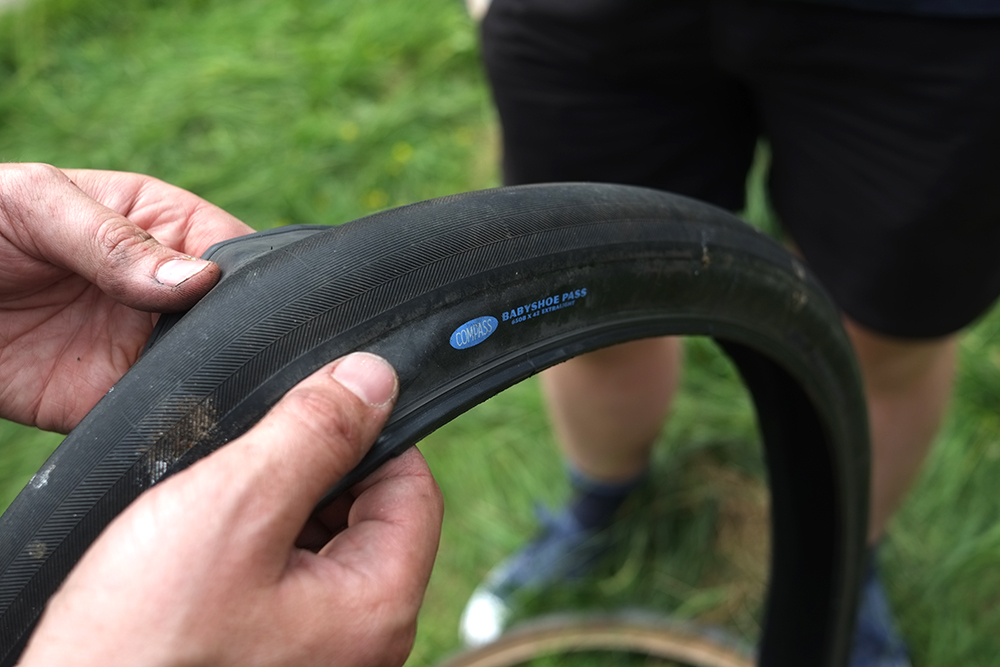
Getting back to the topic of 650B tyres. Damian and I are actually a tough couple of customers, in that we've each tried quite a few already and are both extremely pleased with what we currently ride: Me, the aforementioned Grand Bois Hetres and he the Compass Babyshoe Pass (which he claims are "even better").
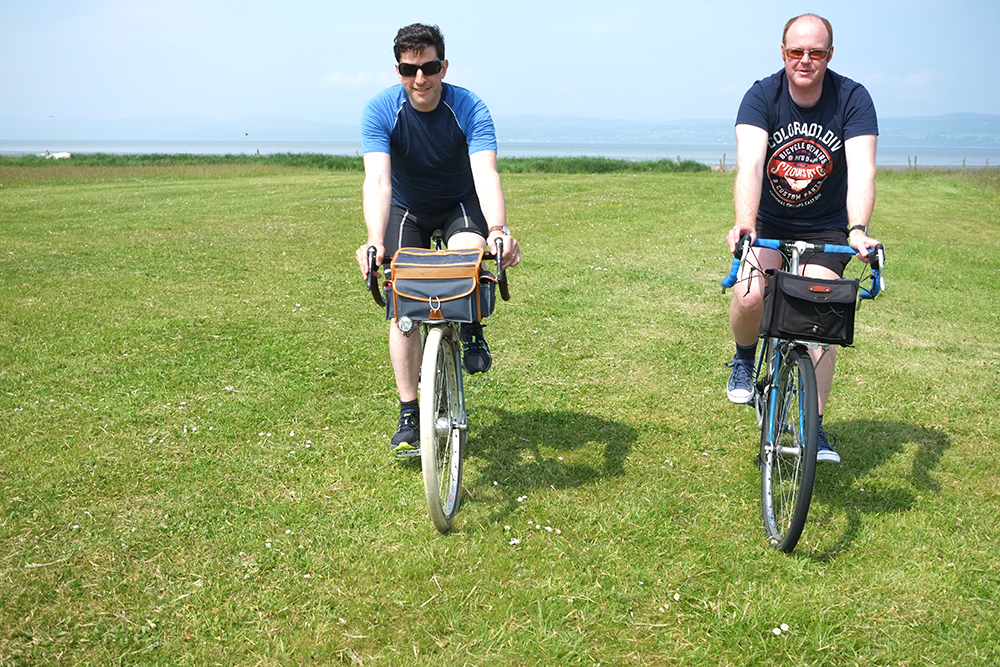
To prime ourselves for the new tyre experience, we first briefly rode our own, then each others' bikes, with their old tyres. Then we proceeded to the difficult task of selecting one pair of new ones each (to do more than that in a day would be overload, we soon realised).
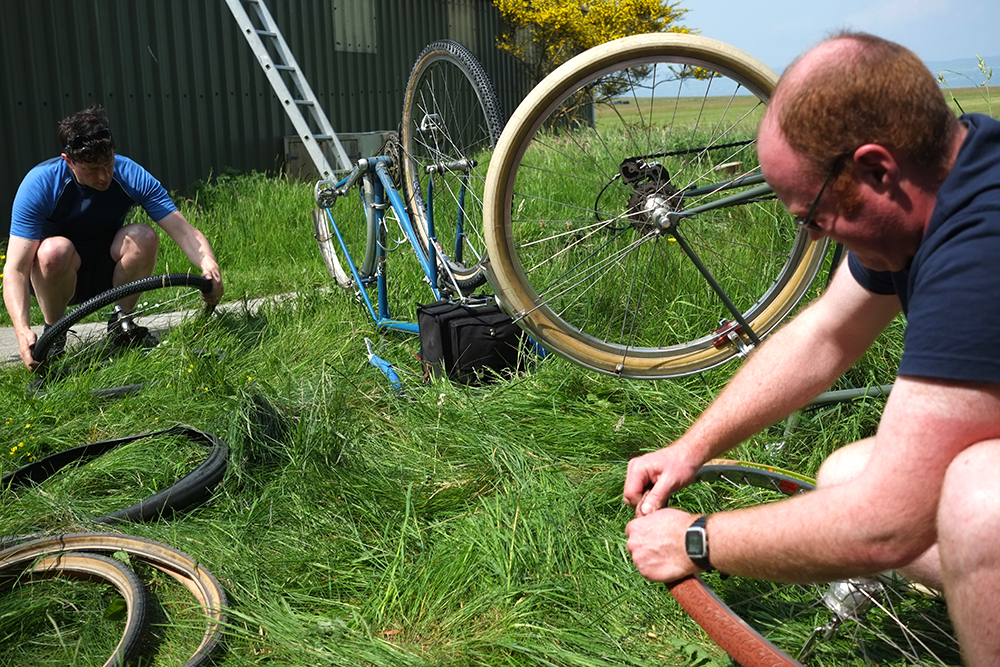
The sample tyres we had to choose from were all in the 38-42mm range, but rather varied in other qualities. When handling the tyres we could not help but notice the difference in their weight, as well as in the stiffness/softness of their casings. Was this what accounted for the "supple" ride quality we loved about some of the ones we'd tried already?
Some of the tyres were of the super-smooth and speedy variety, others were touring/commuting-oriented, others still for predominantly off road use. We decided to try one of each.
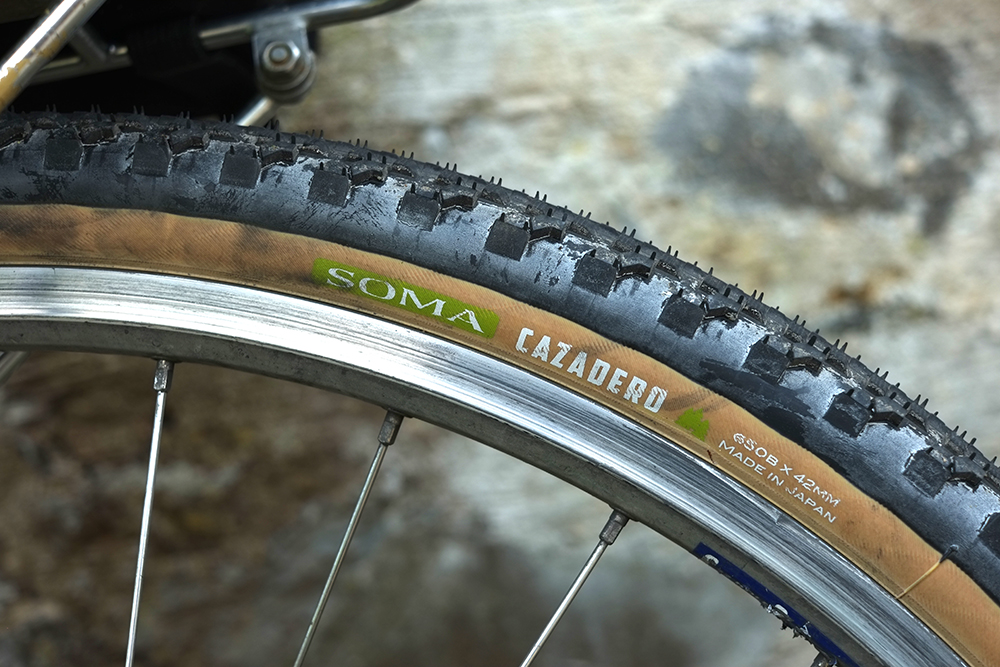
The most drastic change was braved by Damian, whose smooth Babyshoe was swapped for the knobby 42mm Soma Cazaderos.
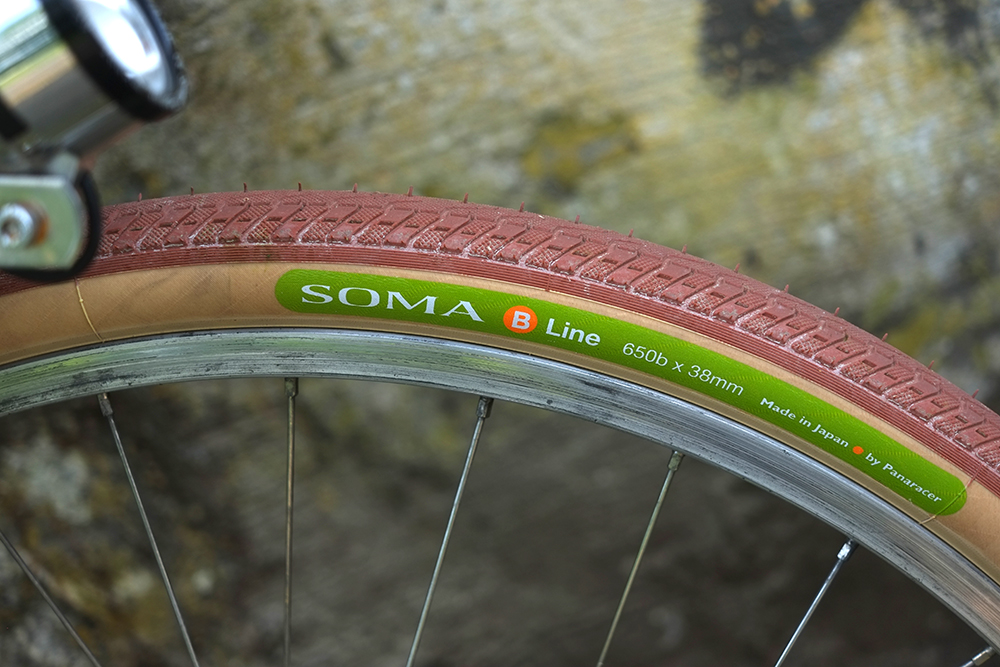
For Alice (formerly shod with Hetres), Bryan chose the 38mm Soma B-lines with terracotta tread.
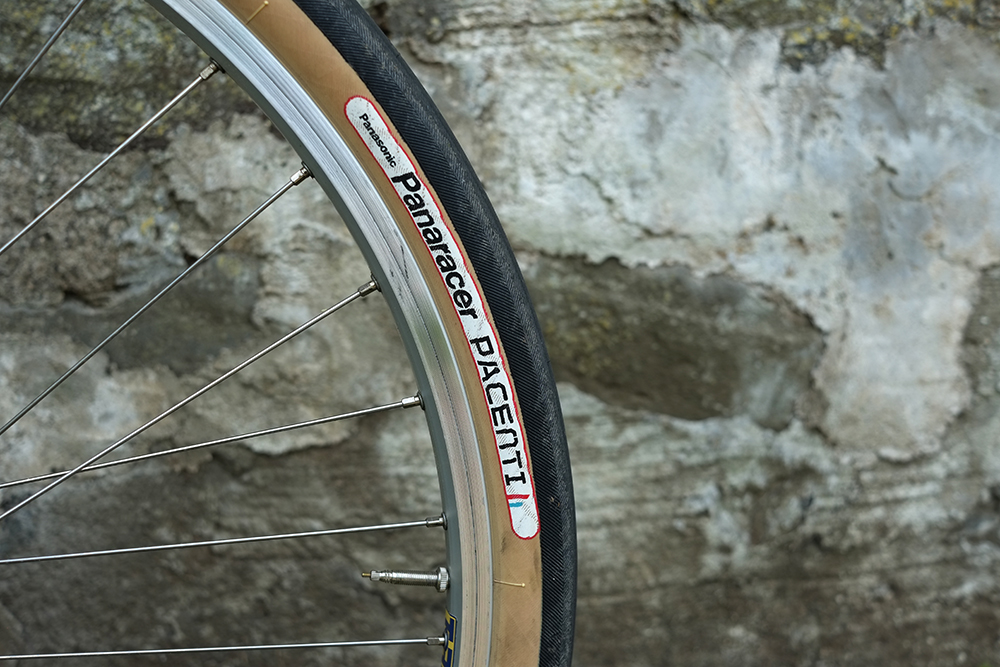
And for the Clementine, which had come to me with nice, all-arounder Panaracer Paselas, I chose the smooth-treaded Pacenti Pari-Moto tyres of the same brand and same 42mm width.
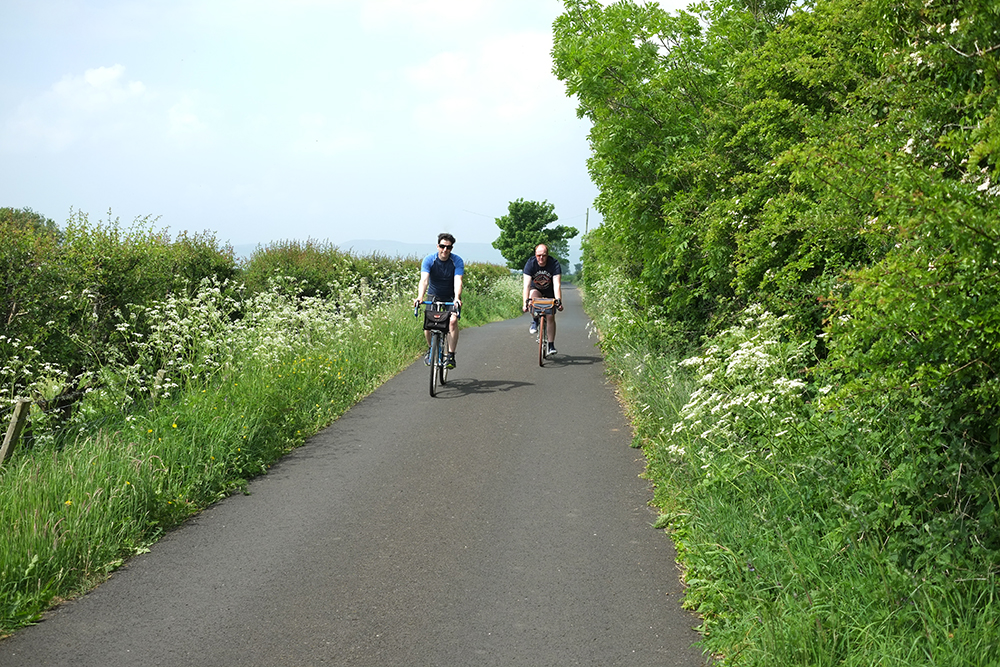
And with that, we set off along the country roads, toward the nearest forest.
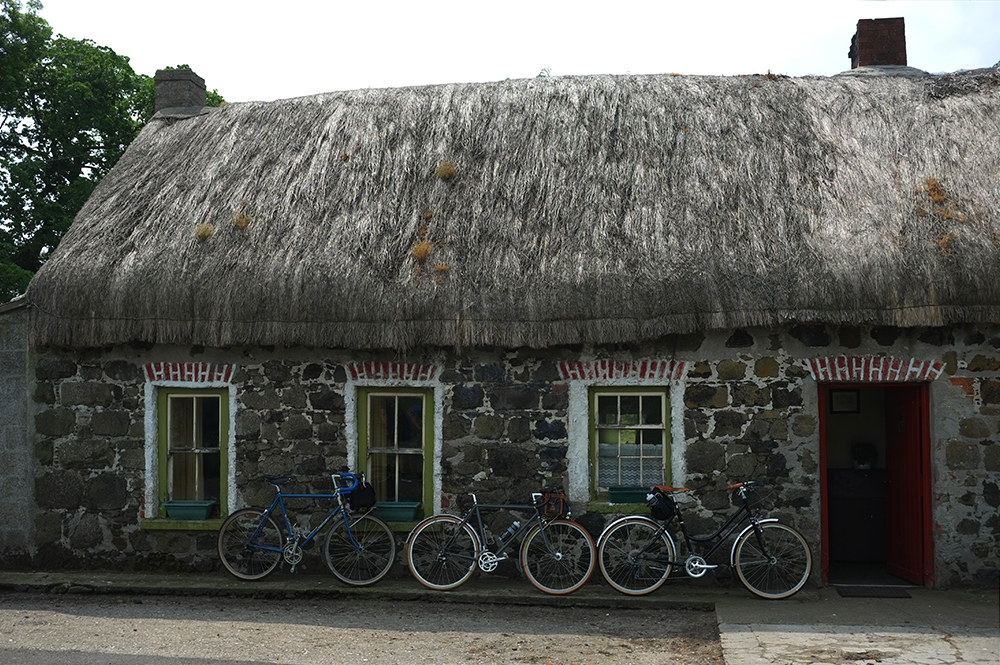
Now, in case you're one of those folks who thinks that Ireland is all dirt roads and thatched cottages (can't imagine who filled your head with that nonsense!), I'm afraid I must dissuade you of such romantic notions. In fact it is pretty difficult to find unpaved stretches of road of any significant distance these days on the Emerald Isle, so super-modern and advanced it's become. But having lived here for nearly 3 years now, I have my arsenal of secret places (can't tell you what they are, for fear they too will get paved!) and it was toward one of these that we headed.
"What do you think of the tyres so far?" I shouted en route.
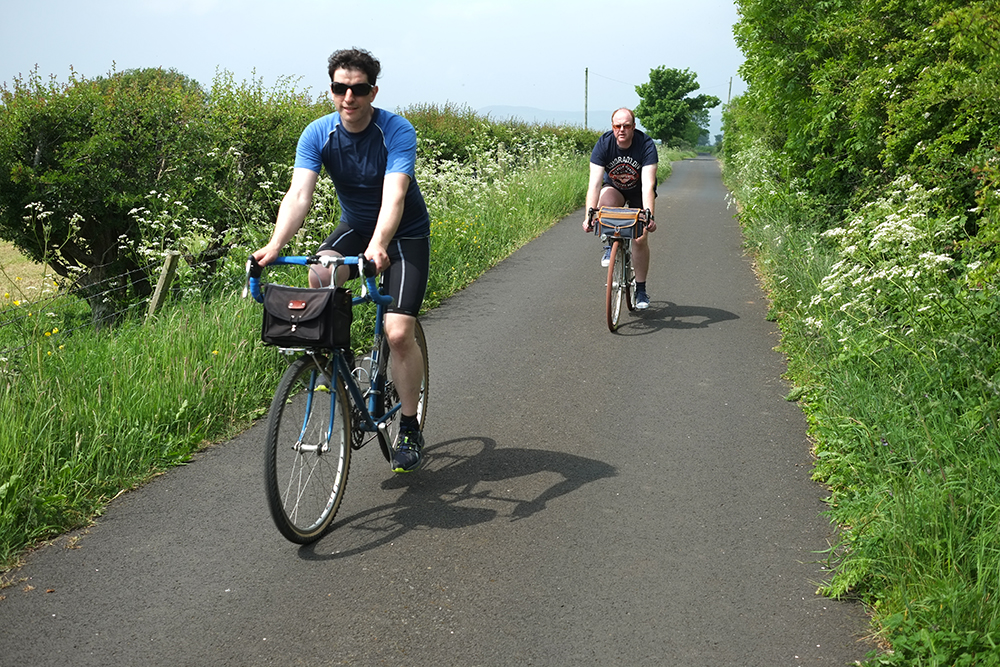
"Ach, sure they're grand!" came the collective reply.
"Less or more grand than the ones on the bike before? Can you quantify the grandness on a Likert scale?"
And then we broke into a chorus of laughter, for surely worse tyre testers than us these country roads had never seen.
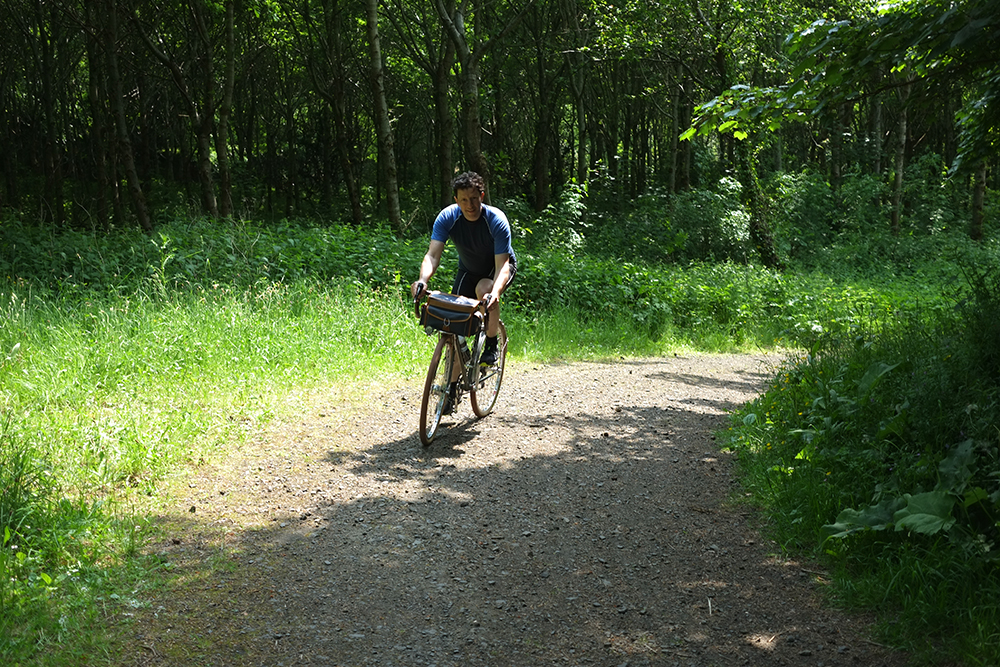
By the time we arrived in the forest, a great sense of relief came over us, as the day was an unusually hot one, and, while Damian was made of more resilient stuff, both Bryan and I had turned an alarming shade of beetroot red. The forest, however, with its lush tree canopy and mixed herbal scents, soon cured that, and we were ready for The Mini-Loop.
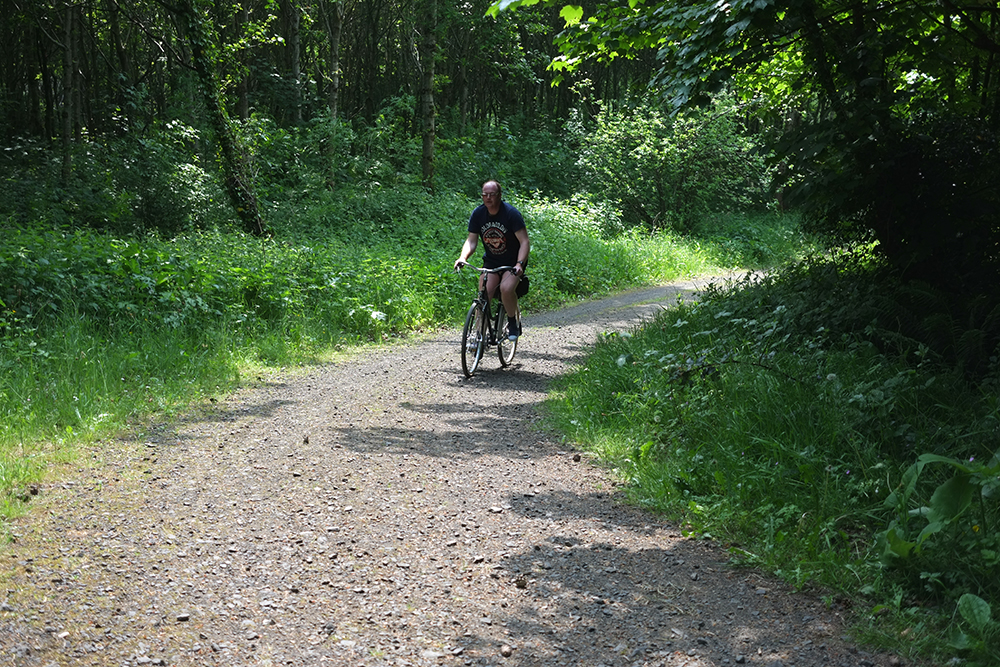
The Mini-Loop is a fantastic place to mess around on bikes. Alternating between rough dirt and loose gravel, it is short but sweet - incorporating both a steep flick of a climb and a screaming descent.
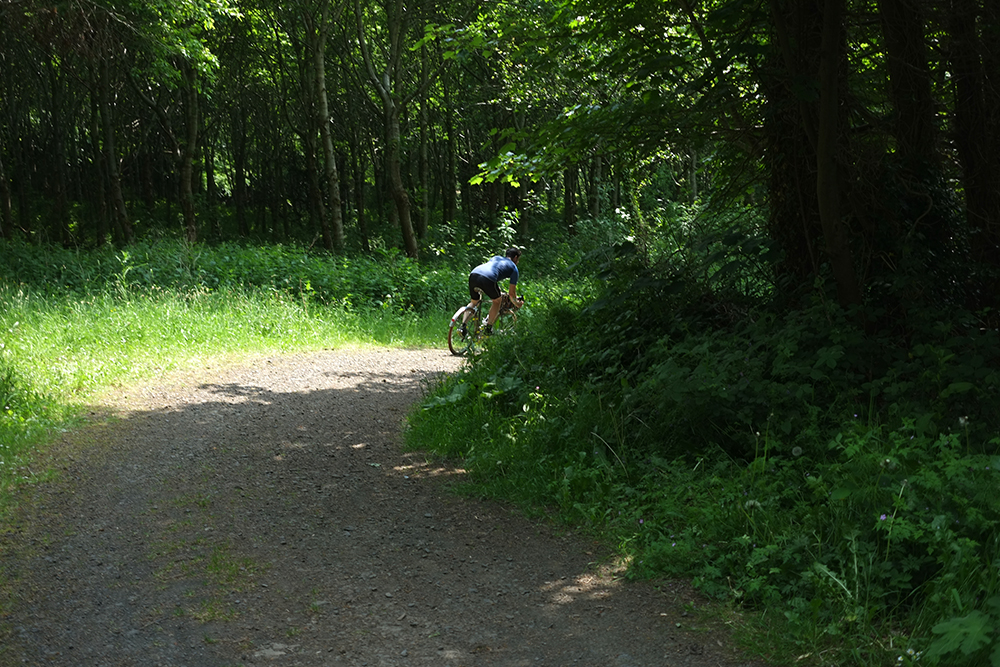
Taking turns, we each "raced" (okay, only Damian raced, while "tackled carefully" probably describes Bryan's and mine style more accurately) the loop on all three bikes... with the exception that I only rode the (too-large for me) Saluki a tiny bit, managing to immediately come close to crashing it when I attempted to stop and hit my undercarriage on the top tube!
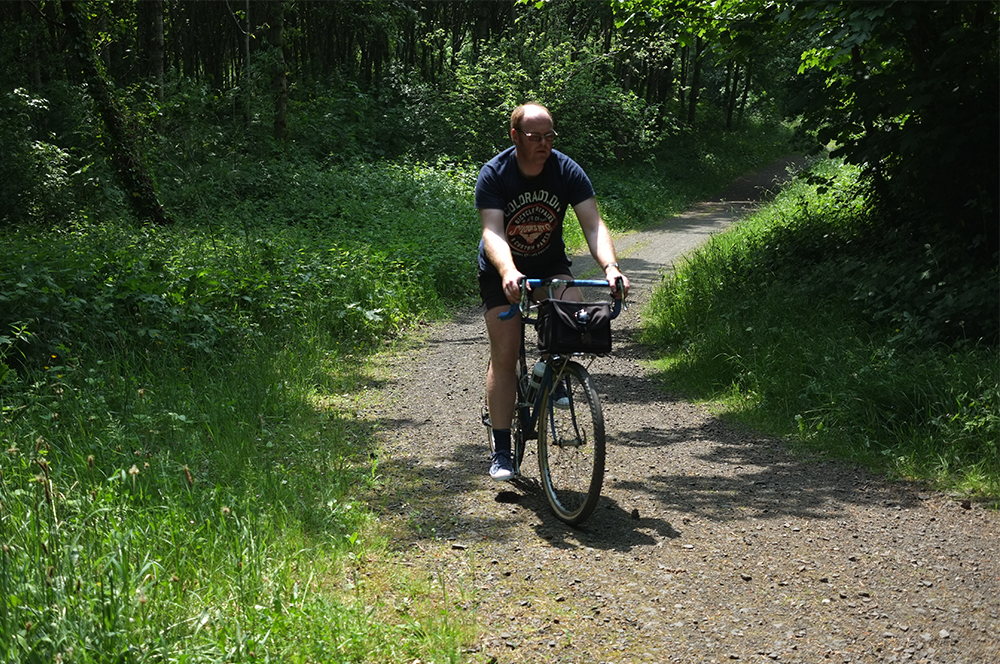
Happily, the boys had no such issues and were able to ride all 3 bikes without incident.
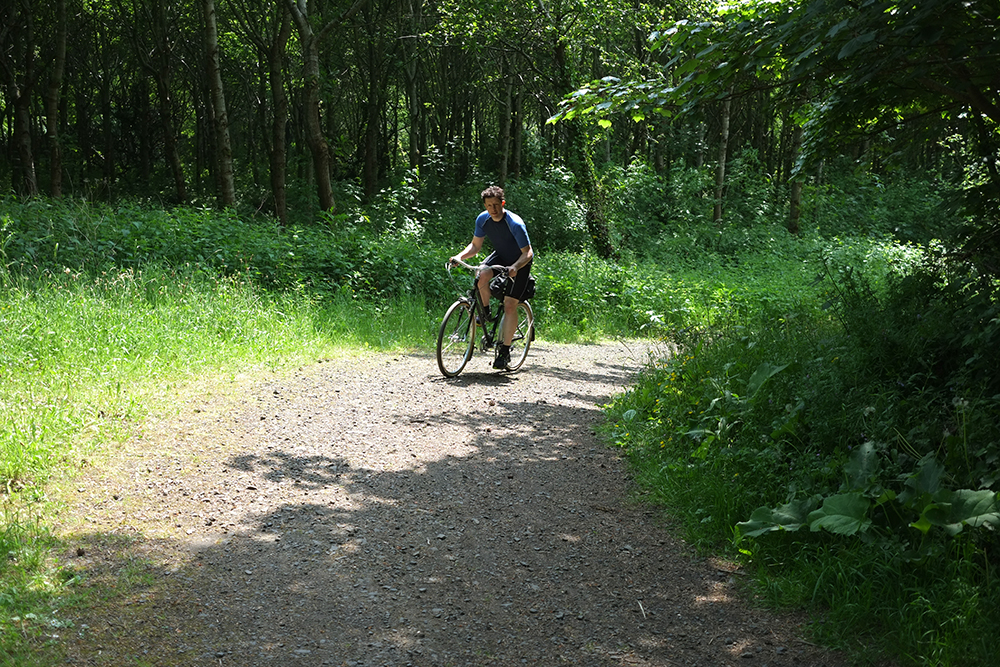
It was particularly cool to see them both on the Rivendell Clementine and on my Alice. I can so rarely get other people to try the bikes I have in my possession. (Something about my bikes being "weird"? What!)
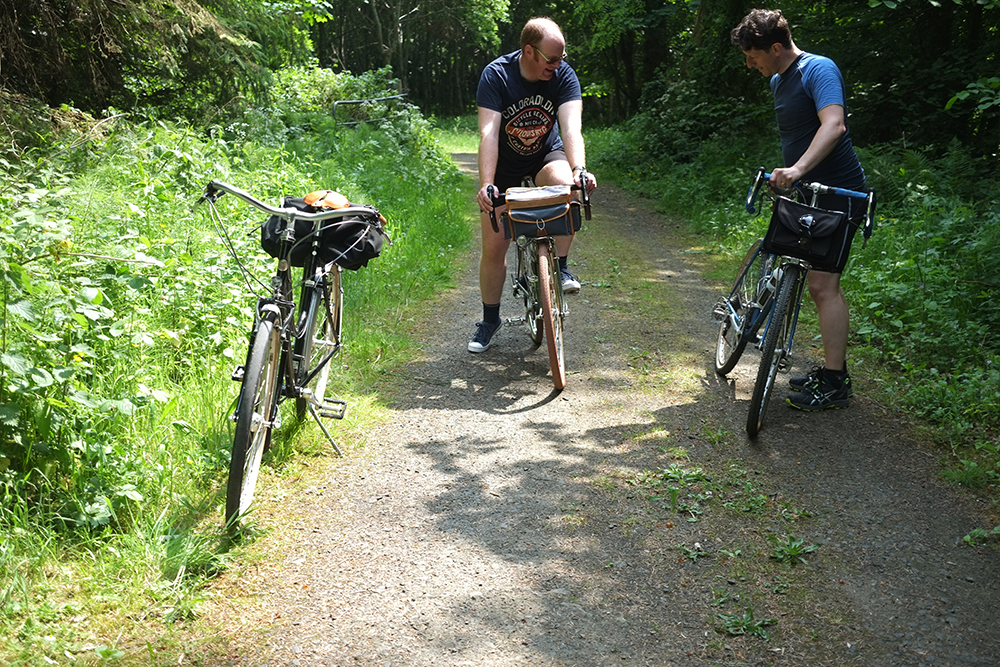
In the throes of our forestine frolics, we eventually remembered that we were meant to be forming impressions of tyres. Luckily, by this stage we had actually managed to form some thoughts.
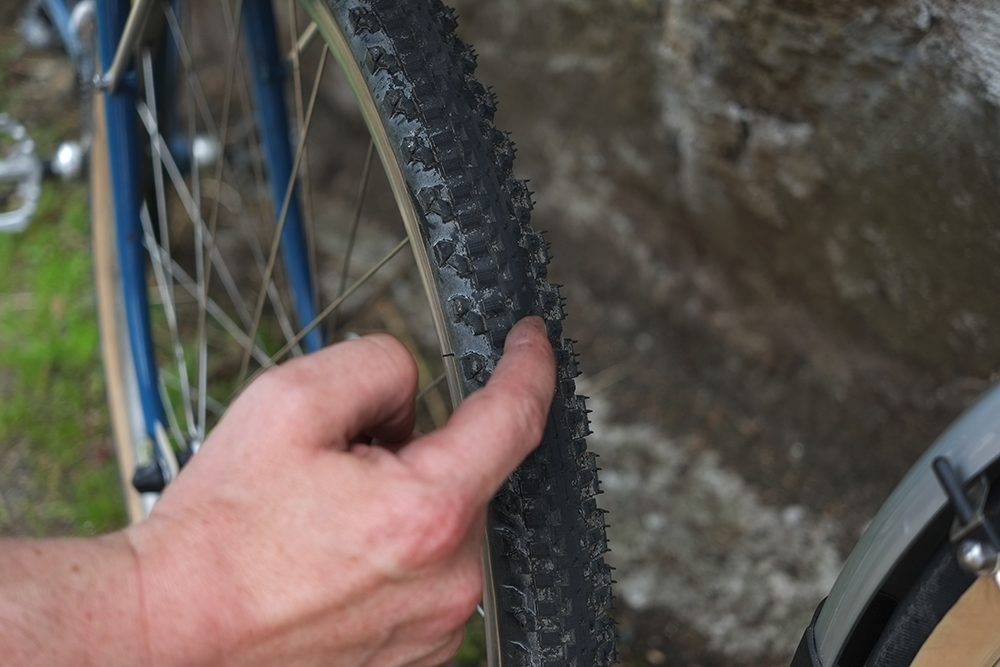
The dominant one we all agreed on, was that the Soma Cazaderos did not feel in keeping with how they looked. That is to say, while they looked like knobbies, they rode almost like slicks - including on pavement. Upon closer examination (we deliberately had not read anything about the tyres in advance), this made sense as these tyres have a "slick" ridge that runs along the centre, which is what makes contact with the ground most of the time. On first impression, they seem like a good option for a mainly off-road tyre which you don't want to feel slow and draggy on the in-betwen pavement stretches either.
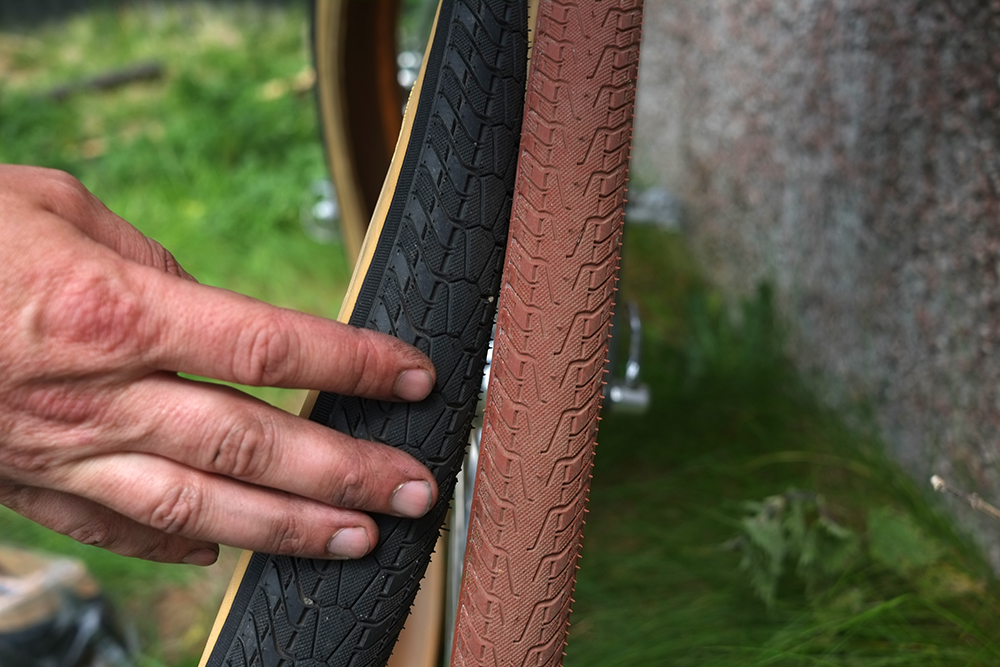
The Soma B-Lines felt "fine," and "on the faster end of commutery," but without anything more punchy or specific that immediately stood out about them. To me, they feel (I still have them on Alice, so it's been a few rides now) remarkably similar to the Panaracer Paselas that were originally fitted on the demo-Clementine - which would make sense, as the tread on the two is nearly identical. (So, if you like Panaracer Paselas, but have always dreamt of them in terracotta, there's at least one reason to go for the Soma B-Lines.) But in any case, while I like these tyres just fine and would have been perfectly pleased with them had I known no other tyres, I have to say that I prefer the smoother, faster-rolling feel of tyres such as my Hetres.

Which is not to say my praises are limited to the Hetres exclusively. The Pacenti Pari-Motos I had tried on the Clementine, I fell in love with immediately. Considering that the bike already felt fast, nimble, comfortable, and great on gravel with the Pasela tyres, I was not sure I would experience a discernible difference with the Pari-Motos, but I did. It is as if all of these positive characteristics became exaggerated. The difference was especially prominent not on the road, as I might have expected, but on the gravel bits of the forest loop. Both climbing the steep bit and descending the winding loose section, the Pari-Motos felt faster and more cnfidence-inspiring than the Paselas. And again, that is not to say that the Paselas did not feel nice (there are those tyres that just feel "dead" and sluggish, but that was not the case with them), but that the Pari-Motos felt nicer still. I definitely prefer them and will leave them on the demo-Clementine.
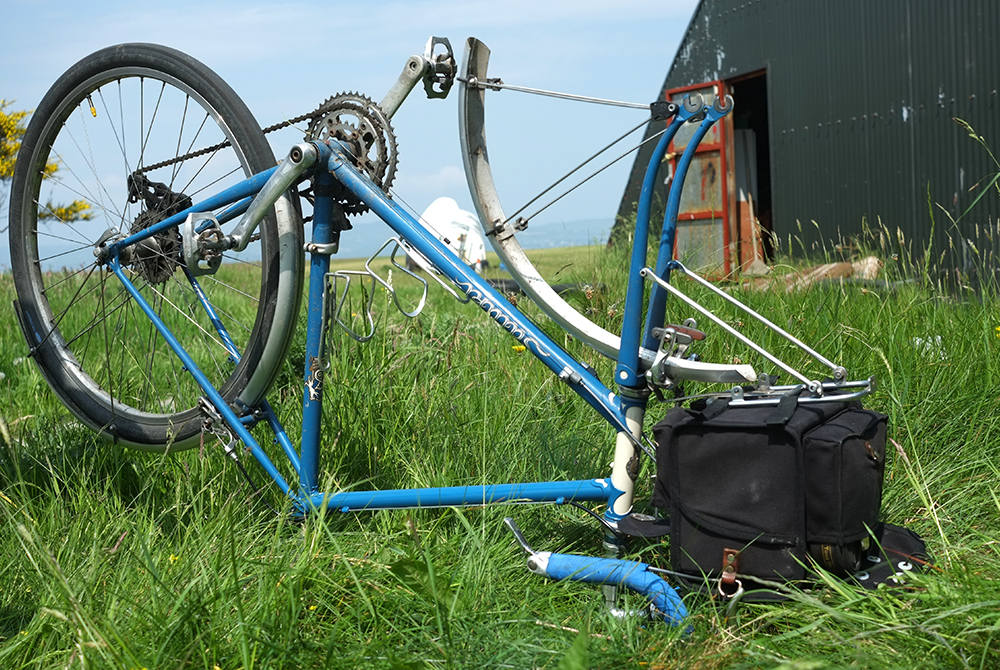
Aside from these 3 pairs of tyres we tried, I had also sent Damian home with a pair of 42mm Soma Grand Randonneurs, which I hoped would be similar enough to the Hetre/Babyshoe Pass ilk, for him to notice subtle differences. He was kind enough to try these tyres for two weeks, on commutes as well as on the Wicklow 200 brevet. He reports as follows:
These tyres are shaped very like the Compass Babyshoe Pass. They are also smooth riding, but perhaps not quite as comfy as the Babyshoe Pass. They sound a bit different, they make a fast swishing noise like 25mm race tyres. I can tell you that they do descend fast like the Babyshoe - I overtook a series of racey types on the descent from the Wicklow Gap towards Hollywood, including a guy on a very zippy carbon thing with very deep rims. At Hollywood we chatted and he said my bike was incredibly fast on the descent. It is, but it's mainly the tyres I think. Still, they're not as comfortable as the Babyshoes but I'm going to let a bit of air out of them and that might change. I got a puncture FWIW but I don't think any conclusions can be drawn from that - loads of other people did too.A puncture? Bin them immediately! No. But it does go to show that really we need quite a lot of time with a tyre to see whether a thing like that, for instance, is an anomaly or a recurring characteristic. Although, in fairness, this too can be person/terrain/context dependent. For instance, I get flats on my Hetres very rarely (on two occasions over 5 years of ownership, to be precise, and one of those was a split tube), whereas others describe the very same tyres as "flat-prone." I am hoping to have the same luck with the Pari-Motos, despite their similar reputation.
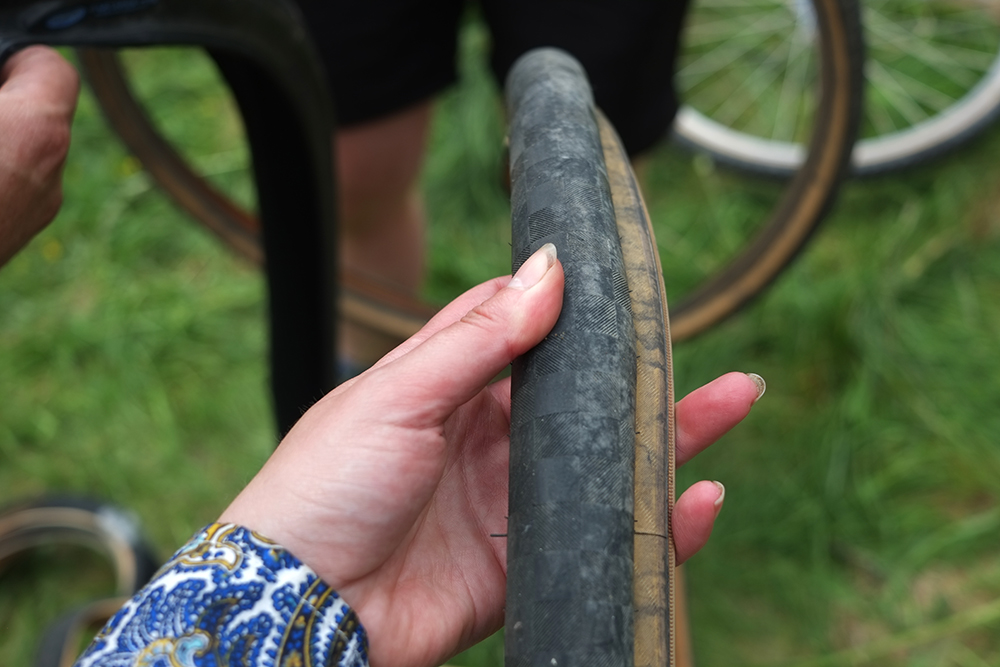
It is amazing to consider just how many options for 650B tyres exist today. And, interestingly, most of them are made by Panaracer.
The originals had of course been made by French companies such as Michelin and Clement, but those have not been produced for some time. When the 650B size was first "rediscovered" (thanks largely to Ebisu, Rivendell and Toei) the Panaracer Col De La Vie and the Mitsubosi Trimline were the main options available on the market. Then came the various Rivendell 650B tyres in increasing widths, and finally the high-performing stuff from Grand Bois and Compass.
Not all modern 650B tyres are Japanese. At some point, the French Confriedes650B group colaborated with Hutchinson to produce some. The Finnish Nokian have been making studded tyres in 650B (you can read about my experience with those here). There is now also a generation of new, mostly mountain bike, 650B tires being produced by WTB (China), Surly (Taiwan), Schwalbe and Continental (Germany) and most recently Clement (not sure where those are made). Still, the usual suspects for the randonneurs and all-terrain roadbike lovers - including Grand Bois, Compass, Rivendell, and Soma - are all produced in the same Panaracer facilities - which is fascinating, considering the dramatic differences in character between some of them.

So, how does one go about reviewing tyres?
Dear readers, I could not tell you. I have considered the topic seriously. I will even admit to making some questionnaires, before scrapping them with a chuckle just before my visitors arrived. For it is one of those things, I fear, where the more systematic and diligent we try to be, the more the essence of the thing gets away from us.
And so perhaps it is the subjective accounts, the seemingly insignificant nuances, the pointless anecdotes - when gathered up from a sufficient number of riders, and over a sufficient length of time, that tell the tale better than even the most controlled and sciencey review.
All I can tell you is: Choose what seems suitable. Stick with what proves enjoyable. Ride, ride, ride. And rejoice at the wealth of 650B options available, should you ever change your mind or want to experiment further.
With thanks to Damian, Bryan, and Merry Sales. Full picture-set can be viewed here and have a Happy Week-End!

Quick correction -
ReplyDeleteIt is amazing to consider just how many options for 650B tyres are available today. And, interestingly, most of them are made by Pacenti.
Do you mean Panaracer?
Yes I do!
Delete{Thanks}
What an interesting experiment! While I have not tried the other tires mentioned, I have tried two sizes of Paselas: 27x1.25 and 26x1.75 and can vouch for their comfort and performance (cushy yet roll without resistance). They are now my favorite tire - good bang for the buck. I am anxiously awaiting my own Clementine delivery and you can bet that when the included tires wear out, I'll replace them with Paselas.
ReplyDeleteOh cool. I hope you like it (and I think you will!)
DeleteLooks like those Cazaderos are built the same way like Clement USH (700c) - knobby on the sides for extra grip in corners on loose surfaces, but with a solid center ridge for a fast ride on pavement. I haven't tried Cazaderos so I can't compare but the USHs are superb. In fact, if I had to choose only 1 type of tire to stick with for the next few years, it could be it. It's fast on road, it's supple (in 120TPI version), it's lightweight (310g), it's great on gravel and packed dirt, off-road, great for touring, commuting, pretty much anything and it doesn't wear out as quickly as some of those super thin and super light Compass tires.
ReplyDeleteRegarding your review, I assume you didn't have enough frame clearance to include some more extreme choices such as Compass Switchback Hill 48mm or Schwalbe Thunder Burt 2.1".
I have only seen (not ridden) those Clement tires, but based on what I've seen yes, same idea. The Continental Cyclocross Speed tires, which I had on the formerly mine (but now really my husband's) lilac Honey try to accomplish something similar in a somewhat different way, but do not do it as well IMO.
DeleteThe Clementine, I am pretty sure has room for 48mm. But I wouldn't really have much opportunity to make proper use of anything that wide, except to ride it on the beach.
Thanks for the review of these. Receiving a fleet's worth of tires in the mail is a bit like Christmas, one would think.
ReplyDeleteI'm almost always ending up with Panasonic tires on my bikes. Whether this is just habit, or not, who knows? I do know that I never find myself displeased with them. Usually a good price/ comfort/ longevity combo in my experience with any of the ones that're used.
I have recently been researching 650b wheels/tires for a nice old steel roadie that I desperately want to fatten up. While I've been resisting yet another tire size to add to my collection, the urge to try a 42mm tire on the bike in question has almost become overwhelming to me, and the only way to make it happen is with 650's. The Pari-Moto in 42mm is what I've decided on, I think. I am glad that it was one of your test subjects, it was nice to see it reviewed favorably.
Seems like you've run a few different 650b wheelsets, if I recall correctly. Any opinion on rims that you like?
Wolf.
"Receiving a fleet's worth of tires in the mail is a bit like Christmas, one would think."
DeleteHeh. Only if one actually wanted that for Christmas (or rather Summer Solstice?).
When it comes to certain things (oddly, tyres and shoes both fit this category) I am really an "if it ain't broke, don't fix it" kinda a gal, which I guess does not an adventurous reviewer make. It was good to have been encouraged to experiment though, even if I do stick with Hetres in the end.
As far as rims, I've really only had the Pacenti, the Velocity Synergy, and now on the Clementine the Atlas. For commuting they are all fine. For "spirited riding" I am not happy with any of them and want to figure out something "racier" and lighter for Alice eventually. Need to do a bit of research there.
I think you meant to say only three rims on 650B wheels. If you really do pursue racy 650s a couple considerations. Wide low pressure tires spread impact loads over a large arc of rim. Between that factor and being light in weight you could get away with almost anything. Building with 16 spokes front and rear would likely work. On the other side one of the reasons you have 650 bikes is so you can ride with loads. Loads are unsuspended weight. My personal conversion factor when thinking about reliability is one pound unsuspended counts as three pounds of rider weight. So back to square one unless you were to have spirited wheels and utility wheels. The simplest way to get performance would be to go for the extra light versions of these tires. I've no idea how they would survive Irish roads. The next step would be to start worrying about rim strip weight, using aluminum spoke nipples, checking inner tube weights, weenie stuff.
DeleteOne thing you could try immediately would be adding talc between tire and tube. Reduces rolling frictions more than you expect. Tires mount easier too. Watch out at extra low pressures, tires always walk a bit at low pressure and the valve gets sideways. Talc makes that happen easier. Don't overdo it and keep an eye out when you first try.
Well, since the comment was asking about 650B rims specifically, I assumed that was assumed...
DeleteCarrying heavy loads is not going to happen on that bike; my fork would probably fail before the rims. That said, I am not looking to go crazy. I just think the 32-spoke wheels I ended up with are overkill for someone of my weight and riding style. I did initially intend to get the 28 hole Pacenti rims, but was strongly dissuaded, and, regrettably, listened.
Anyhow, I am not looking to do this just yet. Maybe next summer, after I sell some parts and do some research. I am finding the world of 650B rims difficult to navigate, what with all the ones made for disc brakes and mountain bikes and whatnot. Getting better informed on what's even available is next on the agenda.
...Wait, unless you're suggestion reducing the spokes on the existing wheels to 16? A couple of people I know have done this, while others have warned against it - so one of those cases of conflicting advice. But at this point I would not be adverse to trying.
DeleteSpoke tensions drop when a tire is inflated to high pressure, so it's possible that high psi tires make a rim less durable, but I do not have concrete evidence to back this up.
DeleteMy Rawland's front wheel is built up with 28 spokes and has been very durable no matter the terrain or front load. There is no reason Velouria couldn't reduce her spoke count fro 32, but to 16? I'm not ready to go there...
And, my Bike Friday cargo bike is built up with a 20" front wheel with 28 spokes, laced 2x, and even for a cargo bike with disc brakes (and hence lots of tension dynamics going on with the spokes), it's been rock solid.
Anyone remember Lon Haldeman? Big guy. Strong guy. Very big. Very strong. The rides that made the legend were done with 12 j-bend wire spokes in the front, 20 wire spokes in the rear. Handbuilt wheels. He also worked those wheels extra hard by mounting Panaracer Rapide tires at 150 grams and 17mm width. Myself I once had an MTB wheel I built myself from pretty normal parts, only 14 spokes, used it a couple thousand hours (off-road is hours, not miles), decided I was just too old for off-road, gave it to a stunt rider who complained because he just couldn't break it. Harder use than V is likely to put on a wheel. And both myself and that stunt rider were 85 kilos plus.
DeleteYou don't do this at random. You pay a lot of attention to a lot of details. A sixteen spoke rear would definitely be an experiment. Sixteen spokes in the front feels normal to me. Twenty spokes in the rear is very normal,in the right circumstances. My experience is 24 rear is more durable and trouble free than 28. Done it lots of times lots of different ways. Yes there are potential pitfalls. Yes there are lots of people who try this and do everything wrong, tell the world it doesn't work. I am not a genius mechanic, not a genius wheel builder, I have had no problems and I have been doing just this for thirty years now.
Someone who masses 60 kilos does not need wheels built for riders who mass 100 kilos plus. If you read all the comments here up above I told you about a 16 spoke wheel I built with a 320 gram clincher rim that went 10,000 miles with zero problems, retired only due to caution about brake track wear.
If you go and do something silly I am not responsible. If you build a sensible wheel it will work.
V@ 4:31
DeleteThat last sent too soon. I was about to say that for rear wheel use you have a problem because only 32 and 36 rims exist. In 700 you can go ahead and build from tandem-drilled rims. In 650 you are either out of luck or you go ahead and build a 16 rear. I would build and ride a 16 rear for myself if I were interested, wouldn't much trust it until I'd gathered some miles, spoke life would be brief. A 60 kilo rider would be a more likely candidate for that experiment. I'd give that a 95% chance of working. If you don't like those odds, don't play. You have industry contact, get them to drill you a 24. Or get a blank and drill it yourself. A 24 would be completely understressed under a light rider, it would last exactly as long as a 32 would last for that rider. Except for weight and speed it would feel exactly like a 32.
A comment got lost. Oh well.
DeleteA bit of history for an old thread.
DeleteI built my first 18 spoke wheel in 1977. I was not the first or even the first on my block. We saw the photos of the pros and the English time triallists and got building. It was so easy. Since 32 spoke wheels had been de rigueur for quite a while there were loose 36 hole hubs. Shops had dead stock in 36 hole rims. Top quality Connecticut made butted spoke were $0.03 each. And radial laced wheels are simple to build. Those wheels worked.
Mostly those dead stock rims were cheap French and not much good. Very flat section rims and quite flexible. Nothing like as good as 50s and 60s rims with the same stickers. No rims in current production are so soft and weak. Nevertheless they worked.
Some things were learned from this fooling around. Wheels are enormously sensitive to weight. Wheels that had been fine and fun would be too darn flexy simply because the rider put on ten pounds. Or even from overloading pockets and water bottles for a long ride. Then a build combination that had been perfect with 18 spokes would just not be rideable if repeated with 16. And spoke tension mattered a lot. Home built and shop built wheels with 32 or 36 spokes could be and were built almost without regard to spoke tension. The 18 wheel just had to be tight.
I should add that I was a much lighter fellow 39 years back. People generally were lighter back then. The line for who would like their 18 spoke wheel seemed to be around 160#. Big guys just could not ride a wheel built to this formula.
Then a generation of much stronger rims came along. You had to pay for them, they were worth it. The Lon Haldeman wheels mentioned above were a culminating point of that. Except for the shop-drilled rims they were completely normal shopbuilt wheels. Lots of them were sold retail to normal mortals and they were unproblematic.
Just before all this entered general consciousness two things happened. First rear hubs went to 130mm, initially to accommodate 8speed cassettes. This rendered 98% of all tubular rims obsolete overnight. Pretty much the same for clincher rims. Then system wheels appeared. Since everyone always apes what the pros do wheelbuilding went into a deep slumber.
I was building wheels all through this evolution. One thing I can tell you is that 24 spoke wheels are enormously stable. 24 is 2x2x2x2x3 and that configuration is marvelously crossbraced in every direction. With nearly any rim (there are and will be exceptions, mostly due to QC issues) any rider under 90kg is understressing every component of a 24 spoke wheel. Light riders can go with a lot fewer spokes. Pre-built system wheels are seldom built one bit better than what you can build yourself. Home built is limited by available drillings.
Up above I told you about the stunt rider and the 14 spoke wheel. That was a Campagnolo K2 rim, very nice and very unobtainium. That same rider normally rode steel rims that weighed four or five pounds each and had 48 spokes. He broke those with regularity. More weight and more spokes do not make a wheel stronger. Good design, good parts make a wheel strong. My old coach Othon Ochsner rode 24 spoke wheels back in 1919. Much better parts are available in 2016 than were extant in 1919. 32 spoke wheels are a throwback.
@Anonymous 2:57;
DeleteI find your experience with reduced number of spokes very interesting indeed. Let me see if I get it right. Cause I want to build a light Randonneur bicycle for my daughter, who is around 100lbs. First of all: the choice of 650B rims for Cyclotouring with rimbrakes is very limited and the number of spoke holes even more, mostly 32 or 36h.
So I could build a wheel with a 36h rim and hub with only 18 radial spokes by leaving every other hole empty. That should be easy to do, I guess with heads in to maximize stability? But what do you do with the empty holes in the rim to prevent water and moist from entering the rim?
Next to the 24 spoke rear wheel. Again this would only work with 36h rim and hub by leaving every third hole in the rim empty, right? Would the pattern still be 3 over 1?
I hope you can clarify!
Regards, Frank
Lovely and extremely helpful article!
ReplyDeleteAnd I did not know the Pari-Moto's came in 42mm! That is very exciting! I thought they only came in 38s here in the U.S. I'll have to do some tire-hunting.
I also remember them being available in 38mm only, so this might be a fairly recent phenomenon. They are actually labeled 1.75" (=44mm), but are really 42mm. Quick search shows that as available in that size from Soma, Harris Cyclery, and even Amazon (blackwall only).
DeleteI've been very happy with Panaracer Col de la Vie tyres, both in 650A (unfortunately becoming almost impossible to obtain) and in 650B (more common). Sadly, they are not made in 700C, so I'm using Soma Supple Vitesse tyres now.
ReplyDeleteI did not read this article. All I did was look at the tires' photos.
ReplyDeleteI don't care how well they ride, what size they are, how much they weigh, or how well they shed mud or water.
I use my bikes for recreation, travel, and especially for commuting. My commute begins at 4:15 or 4:20 AM, when it's dark. Sometimes, as every traveler knows, the day doesn't go as planned, and the sun sets before the day's riding is over.
None of the reviewed tires come with a reflective sidewall -- an inexcusable omission -- and a non-starter for me. Schwalbe and Continental manufacture excellent tires, with this simple, effective safety feature.
You are right that none of the tyres shown here feature reflective sidewalls, which is true of most 650B tyres. As you say, Schwalbe and Continental are exceptions. But also the (32mm) Hutchhinson Confrerie tyres, which (for those who care about that) are more road-performance oriented.
DeleteI'm not convinced that reflective sidewalls are an effective safety feature. To be visible to reflective light, the light source needs to be at 90 degrees from the tyre, which means that if a driver has seen the tyres the bike is already directly in front of the vehicle. A good headlight and taillight are much more effective as they can be seen before another light source is at 90 degrees to the bike.
DeleteMaybe quibbling, but that's my opinion on the subject...
Dear NHcycler,
DeleteA five-dollar can of reflective clear coat durably turns sidewalls reflective.
I don't personally see the benefit (see Jonathan's comment), but it meets the legal requirement for wheel reflectivity in some jurisdictions.
Best Regards,
Will
William M. deRosset
Fort Collins, CO
Reading the above, I think the type of wheels you ride could always be considered as a limiting factor to your choice of tires. For it seems to me that I am restricted to the use of the Hutchinson Urban Demi-Ballon (44 - 584) since the Rigida Superchromix rims on my Oscar Egg Mixte are of the old fashioned non-hooked type and I don't think they would take the modern non-clincher tires you tested. This may not be entirely true as some have pointed out to me, but in this case I like to be on the safe side ond dont want to risk a blow out at all. On the other hand the Hutchinsons - although much cheaper and of lower quality than the ones you haev described here - offer a pleasant ride in town- and semi-country conditions and they do well with rain. BBy the way they respond much better to the road surface and are more comfortable and at the same time zippier than the 650 x35B of the same maker that I tried on this bike - making them feel paradoxically slimmer than the smaller ones.
ReplyDeleteThat is interesting and not something I've considered.
Delete...But getting back to "on my Oscar Egg Mixte" - what! Please, for the love of god, tell more of this!
Actually there is not much I can say about the bike apart from the fact that it was owned by Madame Giselle Darnaudet of Leon in the Departement of Landes for most of its bike-life as the owners badge on the frame confirmes (I also found considerable amounts of sand of the nearby atlantic beaches when cleaning the bike). It is painted in an off white colour with red pin stripes and the heavy scratching on the upper tubes indicates that errands were run with the bike quite frequently with bags dangling from the handlebars. Apart from the saddle - the original one must have been replaced some time by a plastic Reydel - the bike came to me fully complete with Lefol mudgards, Vitalux lighting, a "constructeur"-rack and Bebolux brakes. By the latter I would say it was build around 1950. I got it because there was not much interest in it when this lovely lady came up on german Ebay about a year ago.
DeleteYour mention here of tires that warrant 650B conversio begs a questionew I've been mulling over: Why was the faux-Pinarello not built up as a go-fast 650B racer? Is the frame limited? Could it fit 650Bx38s? I've recently been interested in building this type of bike for myself and had been wondering if any nice Italianframes make adequate candidates.
ReplyDeleteThe Pinarello owner had no interest in that, or in fat tyres.
DeleteBut that aside, the faux-P frame has too much bottom bracket drop for a 650B conversion, which is also true of most Italian race frames from that era.
My custom Riv with 80 mm bb drop has now got 584/38 mm PariMotos. Very, very nice ride and no problems whatsoever. Don´t hesitate to try. My work horse have the 42s, no punctures.
DeleteSipelgas
Why not just look for a real oldie that will fit 700x35 in the rear? And if it fits a 35 in the rear it will probably take a 700x38 in the front. You will want wider rims as well as wider tires. Old bikes usually need new rims and spokes anyway. Almost always the original brakes on an old one will work no problems with the wide tires. Plus if you discover your "conversion" is not to your liking any frame that swallows a 700x35 will handle 650x38. With a good chance of 650x42.
DeleteIf both tires have round profiles switching from 622-23 to 584-38 lowers the BB all of four millimeters. If you can fit the 650-42 then BB height remains the same. Bikes work just fine with a much wider range of bottom bracket height than current fashion dictates.
Alas, I don't have a 650b bike (yet), but I see you have Col de la Vies in your comparison...I put those on my Phillips 3 speed (really, a cheaper, rebranded Raleigh Sports), and instantaneously fell in love. I had had Bell blackwall cheapo tires on it before, and my ex girlfriend had Schwalbe Delta Cruisers on her Sports, and neither were even close to these. I've ridden 700c tires of all shapes and sizes from 21 to 42mm width, and flat out no tire has ever felt so good to me as those.
ReplyDeleteI keep hearing such good things about the Grand Bois tires (specifically the Hetres), but honestly, they'd have to roll like butter down a warm roll for me to even consider them given the higher cost of admission over the spectacularly perfect CdlV's.
If you like the Col de la Vies, you will love pretty much any of the tyres mentioned in this post, as they are YET another level above in performance and comfort. That said, not every bike needs that kind of tyre. And note that some report the super-supple ones being puncture prone.
DeleteYou are not a weight weenie yet. Comparing Pasela to Pari-Moto is comparing a 500g tire to a 300g tire. Of course the light tire feels fast.
ReplyDeleteClementine is made to accept 60mm rubber. You are allowed to use smaller and it will be fine. There are some amazing tires now in the big width. Light ones too.
The photoed part of the descent looks like a let 'er rip joy ride to me. Clementine has to be one of the most stable bikes ever made. If this is still a "tackle carefully" it is past time to re-evaluate.
I've been on the 650B bandwagon since 2010, when I started my first (and still most ambitious to date) 650B conversion of a Japanese touring bike, which Velouria featured on this blog more than four years ago (http://lovelybike.blogspot.com/2011/03/creamy-dreamy-650b-conversion.html). Back then, Hetres were the de facto king of smooth supple 650B tires, of which there were only three mainstream options at the time, if I recall correctly: Hetre, Pacenti Pari-Moto (not the same Panaracer Pari-Moto sold today, but close) and the Panaracer Col de la Vie. There was also the Grand Bois Cypres, but that was only 32mm, so not in the same "demi-baloon" category as the other three. The Pari-Motos were considered "event" tires because of their very thin tread, which would wear after just a couple thousand miles and become exceedingly flat-prone.
ReplyDeleteSince I do a lot of mixed-terrain riding, I was eager to try the Soma Cazaderos, but my experience with them differed from Velouria's report: despite the smooth center ridge line, I found they weren't particular smooth rolling, they felt heavy, and they made a buzzing noise on pavement. I've since swapped them out for Compass Babyshoe Passes, in the "Extralight" casing variant. In my experience, these are the ne plus ultra of fast, smooth 650B tires and I have no issues riding them on rough terrain.
A case of YMMV for sure. I wonder whether the quality of the pavement (more or less smooth vs chipseal-esque, like here) plays a role.
DeleteThis sums up my issue, in general, with all reviews. Your circumstances are different than mine, your experience is different, and your preferences are different. Over time our thoughts also may change. I appreciate somervillain's observations.
DeleteI think the Col de la Vies tires are a great choice on a budget. I have to echo your love for the Hetres, I am generally not much on smooth/slickish tread tires, but they do ride great. I did have some problems with them in the Spring (new green goat head thorns) and again in the fall ( old dried brown goat head thorns!) So I probably compromised their performance by adding tire liners, but absolutely no flats since then! I have heard great things about the Compass Babyshoe pass tires, but they are a little pricy so I guess I have to wait for now. -Mas
ReplyDeleteHalfords Carrera hybrids have been coming through with 650B / 27.5” / 584 mm (effectively the same size) wheels for over a year now, replacing their 26” / 559 mm wheeled hybrids, so the wheel size is getting to be mainstream in the UK, and not just for MTBs. I’ve got a 27.5” (650B, effectively) Carrera Subway with 584 x 48 mm tyres; it’s still in its box, but I’d love to have built it up and come over and helped with the tyre test (I live about 100 miles north east of you, as the seagull flies), although I’d probably just have assessed the tyres as ‘great’, the Scottish equivalent of ‘grand’, especially compared to the original Kenda tyres on the Subway, so you’d still have been none the wiser!
ReplyDeleteI’ll probably fit the Subway with Schwalbe Big Bens once the Kendas wear out (but keep dreaming about the tyres in your test!) – I think Schwalbe has the largest selection of reasonably priced (aka pleb-accessible) ‘road’, as opposed to MTB, 584 mm tyres, the extent of which might surprise you if you haven’t looked for them; expect Continental to follow suit soon.
Excellent. I'll have to visit Halfords now just to have a look at the new 650B hybrids!
DeleteThe whole YMMV thing is true. That some people find the Hetres to be puncture-prone seems odd to me, as I've just done 2500km on mine with only one flat (a very stout piece of wire that went straight through the centre of the tread and required tools to extract).
ReplyDeleteI'm a recent convert to 650b, but find the Hetres to roll really well on all surfaces, including rutted gravel and dirt. I've got a set of Babyshoe Passes to try out when these wear out, which might take some time by all reports.
Worth noting that there are now a few options for even bigger 650b tyres: Compass do a 47mm, as do WTB. There is also a Maxxis Refuse in 650b x 2inch, which is reasonably heavy but sounds like it would be good for extended touring.
Pretty exciting times for those who have jumped on the 650b bandwagon.